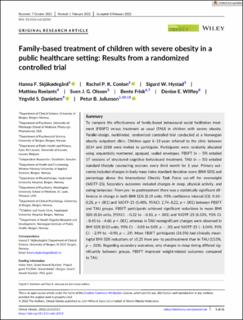| dc.description.abstract | To compare the effectiveness of family-based behavioural social facilitation treatment (FBSFT) versus treatment as usual (TAU) in children with severe obesity. Parallel-design, nonblinded, randomized controlled trial conducted at a Norwegian obesity outpatient clinic. Children aged 6–18 years referred to the clinic between 2014 and 2018 were invited to participate. Participants were randomly allocated using sequentially numbered, opaqued, sealed envelopes. FBSFT (n = 59) entailed 17 sessions of structured cognitive behavioural treatment, TAU (n = 55) entailed standard lifestyle counselling sessions every third month for 1 year. Primary outcomes included changes in body mass index standard deviation score (BMI SDS) and percentage above the International Obesity Task Force cut-off for overweight (%IOTF-25). Secondary outcomes included changes in sleep, physical activity, and eating behaviour. From pre- to posttreatment there was a statistically significant difference in change in both BMI SDS (0.19 units, 95% confidence interval [CI]: 0.10–0.28, p < .001) and %IOTF-25 (5.48%, 95%CI: 2.74–8.22, p < .001) between FBSFT and TAU groups. FBSFT participants achieved significant reductions in mean BMI SDS (0.16 units, (95%CI: −0.22 to −0.10, p < .001) and %IOTF-25 (6.53%, 95% CI: −8.45 to −4.60, p < .001), whereas in TAU nonsignificant changes were observed in BMI SDS (0.03 units, 95% CI: −0.03 to 0.09, p = .30) and %IOTF-25 (−1.04%, 95% CI: −2.99 to −0.90, p = .29). More FBSFT participants (31.5%) had clinically meaningful BMI SDS reductions of ≥0.25 from pre- to posttreatment than in TAU (13.0%, p = .021). Regarding secondary outcomes, only changes in sleep timing differed significantly between groups. FBSFT improved weight-related outcomes compared to TAU. | en_US |

